Posted by admin in Oldblog
on Aug 1st, 2012 | 0 comments
Satthrīyā
 The Satthrīyā dance form was introduced in the 15th century A.D by the great Vaiṣhṇava saint and reformer of Assam, Mahāpuruṣha Śhaṅkaradheva as a powerful medium for propagation of the Vaiṣhṇava faith. The dance form evolved and expanded as a distinctive style of dance later on. Form of Assamese dance and drama has been, for centuries, nurtured and preserved with great commitment by the Satthras i.e. Vaiṣhṇava maths or monasteries. Because of its religious character and association with the Sattras, this dance style has been aptly named Satthrīyā.
The Satthrīyā dance form was introduced in the 15th century A.D by the great Vaiṣhṇava saint and reformer of Assam, Mahāpuruṣha Śhaṅkaradheva as a powerful medium for propagation of the Vaiṣhṇava faith. The dance form evolved and expanded as a distinctive style of dance later on. Form of Assamese dance and drama has been, for centuries, nurtured and preserved with great commitment by the Satthras i.e. Vaiṣhṇava maths or monasteries. Because of its religious character and association with the Sattras, this dance style has been aptly named Satthrīyā.
History: Satthras are the Vaiṣhṇava monasteries in Assam. The saint poet Śhaṅkaradheva of the 15th century AD started this institution to bring harmony to the region of Assam through religion by creating forms of dance-dramas, music, painting and collective prayer. Śhaṅkaradheva introduced this dance form by incorporating different elements from various treatises, local folk dances and his own rare outlook. The dance forms which have come to stay are called Satthrīyā dances, sharing all the characteristics of a classical dance form. Today, although Satthrīyā Nrithya has emerged from within the confines of the satthras to much wider horizons, the satthrascontinue to use the dance form for ritualistic and other purposes for which it was originally created around 500 years ago.
It was in the second half of the 19th century, that Satthrīyā Nrithya emerged from the sanctum of Assam’s satthras. It moved from the monastery to the metropolitan stage. The satthras maintained certain rigid disciplines and austerities within their walls, and until the first half of the 19th century, this dance style was performed in a highly ritualistic manner by male dancers only. The classical rigidity, the strict adherence to certain principles, and the non-engagement of academic research on the dance form all contributed to the delayed recognition and acceptance of Satthrīyā Nrithya as one of the eight classical dance forms of India.
The core of Satthrīyā Nrithya has usually been mythological stories. This was an artistic way of presenting mythological teachings to the people in an accessible and enjoyable manner. Traditionally, Satthrīyā was performed only by bhokots (male monks) in monasteries as a part of their daily rituals or to mark special festivals. Today, in addition to this practice, Satthrīyā is performed on stage by men and women who are not members of the satthras, on themes not merely mythological.
Like the other seven schools of classical Indian dance, Satthrīyā Nrithya encompasses the principles required for a classical dance form: the treatises of dance and dramaturgy, like the Nāṭya Śhāsthra, Abhinaya Dharpaṇa and the Sangītha Rathnākara. There were two dance forms prevalent in Assam before the Vaiṣhṇava movement such as Ōjapali and Dhévadhāsi with many classical elements. Two varieties of Ōjapali dances are still prevalent in Assam. The dancers in a Ōjapali chorus not only sing and dance but also explain the narration with gestures and stylized movements.
 Costumes:The dresses are usually made of pat, a type of silk produced in Assam, woven with intricate local motifs. The ornaments, too, are based on traditional Assamese designs. Specific characters in Satthrīyā dances have their own unique and special costumes. The sūthradhhāra is generally dressed in white: a turban (ready-made, of cloth, sometimes of paper today and fitted often with silvery ribbon stripes), a long-sleeved jama or shirt, and a fluffy skirt (ghuri) tied to the waist with a waist-band with flower designs on it (tangali). For ornaments he puts on silver bangles (gamkharu) studded with stones, a lace with a drum-like golden bead in the middle (matamaṇi), dangling ear-ornaments of gold (unti), and brass anklets (nepur). The gāyan-bāyan singers and accompanists are similarly, but more modestly, attired. Krishna, Rāma and other male characters drape their legs with dhotis and combine this with colourfully embroidered jackets. The gopis and other female characters use bright skirts and shawls. For makeup, colours prepared from vegetable dyes are used, and in most cases characters can be identified by the colours they wear.
Costumes:The dresses are usually made of pat, a type of silk produced in Assam, woven with intricate local motifs. The ornaments, too, are based on traditional Assamese designs. Specific characters in Satthrīyā dances have their own unique and special costumes. The sūthradhhāra is generally dressed in white: a turban (ready-made, of cloth, sometimes of paper today and fitted often with silvery ribbon stripes), a long-sleeved jama or shirt, and a fluffy skirt (ghuri) tied to the waist with a waist-band with flower designs on it (tangali). For ornaments he puts on silver bangles (gamkharu) studded with stones, a lace with a drum-like golden bead in the middle (matamaṇi), dangling ear-ornaments of gold (unti), and brass anklets (nepur). The gāyan-bāyan singers and accompanists are similarly, but more modestly, attired. Krishna, Rāma and other male characters drape their legs with dhotis and combine this with colourfully embroidered jackets. The gopis and other female characters use bright skirts and shawls. For makeup, colours prepared from vegetable dyes are used, and in most cases characters can be identified by the colours they wear.
Compiled by: Aarthi Natarajan & Indira Kadambi
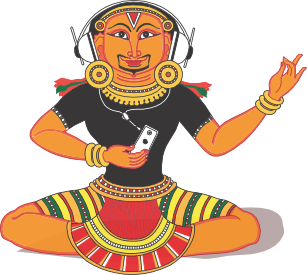
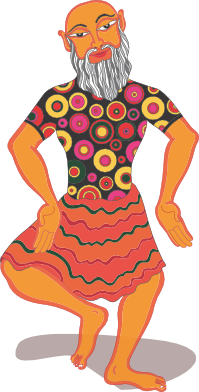
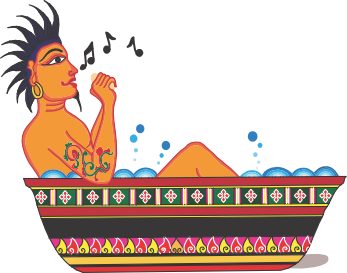
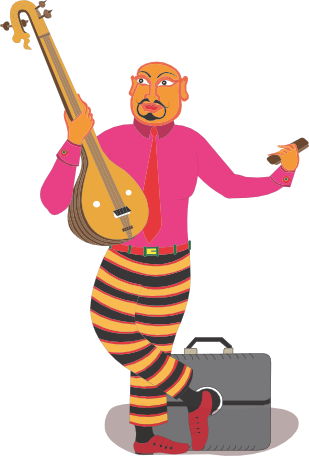
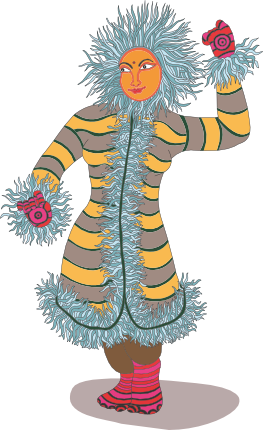
 The Satthrīyā dance form was introduced in the 15th century A.D by the great Vaiṣhṇava saint and reformer of Assam, Mahāpuruṣha Śhaṅkaradheva as a powerful medium for propagation of the Vaiṣhṇava faith. The dance form evolved and expanded as a distinctive style of dance later on. Form of Assamese dance and drama has been, for centuries, nurtured and preserved with great commitment by the Satthras i.e. Vaiṣhṇava maths or monasteries. Because of its religious character and association with the Sattras, this dance style has been aptly named Satthrīyā.
The Satthrīyā dance form was introduced in the 15th century A.D by the great Vaiṣhṇava saint and reformer of Assam, Mahāpuruṣha Śhaṅkaradheva as a powerful medium for propagation of the Vaiṣhṇava faith. The dance form evolved and expanded as a distinctive style of dance later on. Form of Assamese dance and drama has been, for centuries, nurtured and preserved with great commitment by the Satthras i.e. Vaiṣhṇava maths or monasteries. Because of its religious character and association with the Sattras, this dance style has been aptly named Satthrīyā.
 Costumes:The dresses are usually made of pat, a type of silk produced in Assam, woven with intricate local motifs. The ornaments, too, are based on traditional Assamese designs. Specific characters in Satthrīyā dances have their own unique and special costumes. The sūthradhhāra is generally dressed in white: a turban (ready-made, of cloth, sometimes of paper today and fitted often with silvery ribbon stripes), a long-sleeved jama or shirt, and a fluffy skirt (ghuri) tied to the waist with a waist-band with flower designs on it (tangali). For ornaments he puts on silver bangles (gamkharu) studded with stones, a lace with a drum-like golden bead in the middle (matamaṇi), dangling ear-ornaments of gold (unti), and brass anklets (nepur). The gāyan-bāyan singers and accompanists are similarly, but more modestly, attired. Krishna, Rāma and other male characters drape their legs with dhotis and combine this with colourfully embroidered jackets. The gopis and other female characters use bright skirts and shawls. For makeup, colours prepared from vegetable dyes are used, and in most cases characters can be identified by the colours they wear.
Costumes:The dresses are usually made of pat, a type of silk produced in Assam, woven with intricate local motifs. The ornaments, too, are based on traditional Assamese designs. Specific characters in Satthrīyā dances have their own unique and special costumes. The sūthradhhāra is generally dressed in white: a turban (ready-made, of cloth, sometimes of paper today and fitted often with silvery ribbon stripes), a long-sleeved jama or shirt, and a fluffy skirt (ghuri) tied to the waist with a waist-band with flower designs on it (tangali). For ornaments he puts on silver bangles (gamkharu) studded with stones, a lace with a drum-like golden bead in the middle (matamaṇi), dangling ear-ornaments of gold (unti), and brass anklets (nepur). The gāyan-bāyan singers and accompanists are similarly, but more modestly, attired. Krishna, Rāma and other male characters drape their legs with dhotis and combine this with colourfully embroidered jackets. The gopis and other female characters use bright skirts and shawls. For makeup, colours prepared from vegetable dyes are used, and in most cases characters can be identified by the colours they wear.